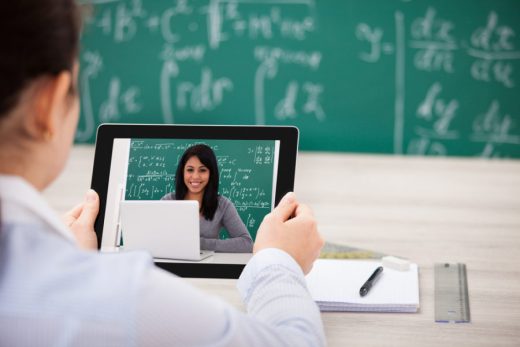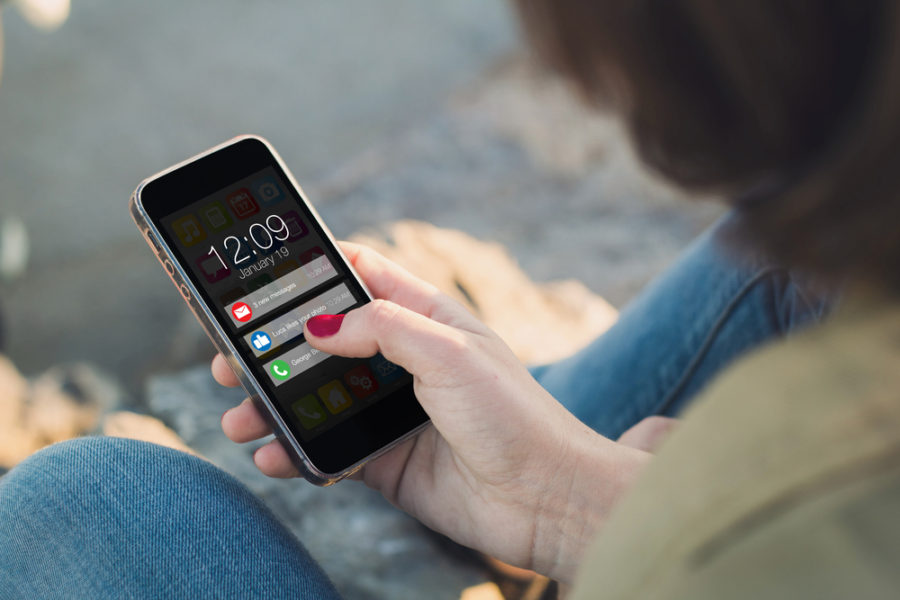How Teachers Can Leverage Mobile in the Classroom
October 24, 2016

If you’ve spent any time at the front of a classroom in the last 5-7 years, or tried to get the attention of a teenager or college-aged student recently, you have quickly become aware that they check their mobile phones a lot. Even if your classroom or school has strict no cellphone policies, chances are students are still using their mobile devices.
In the past, we as teachers only needed to worry about students causing distractions for other students, but now we have to compete with the likes of the Kardashian’s, super-star athletes, famous YouTubers, funny animal videos and everyone else.
Students have more things to look at and engage with than ever before, which means it is harder and harder to hold their attention. While many of us may lie awake at night thinking of a cell phone free classroom, the reality is, that’s not going to happen. There could be a bright side to mobile for educational institutions. We just need to look at apps through the right educational lens.
There’s No Beating Mobile

Again, mobile devices provide an unlimited number of distractions for students because they can engage with any other being on the planet who also has a mobile device, whether that is the student sitting two rows up, in another classroom, Aunt Sue, Beyonce, or even major brand names like Red Bull, Apple and others. When you also consider that over 80% of college-aged adults own a smartphone or other mobile device, then you get a clear picture of why we can’t beat mobile in the classroom. So as they say, if you can’t beat ‘em, join ‘em!
Detractors of going mobile inside the classroom are going to argue that if we empower students to use mobile devices inside the classroom, they are only going to be distracted more. But I would argue that part of the reason that our mobile devices are so distracting is not so much the content, but how it is being delivered. Sure, the latest Hollywood gossip may be more interesting than learning the Pythagorean theorem—in the eyes of students. But the major reason they are tied to their devices is simply because the medium is much more interesting; it is something they can physically touch, move and manipulate with their hands.
By integrating mobile into the classroom experience, we can create a learning environment that is truly aligned with the current Common Core standards. 42 states in the nationwide have adopted the Common Core approach to education. “The standards are designed to be robust and relevant to the real world, reflecting the knowledge and skills that our young people need for success in college and careers. With American students fully prepared for the future, our communities will be best positioned to compete successfully in the global economy.” As educators, we now have “college and career readiness” to add to our already heaping plate of things to worry about. Why not use the tools mobile has to offer to make it easier?
If we can provide students with engaging apps that allow them to interact with educational content in ways that are more natural to them, we can easily help them reap the benefits that real life learning truly has to offer. If we are sincerely preparing them for the future, we need to do so with the tools they will use in the future—mobile apps.
How to Enhance the Classroom with Mobile

The mobile education market is expected to grow by at least 21% over the next five years. This means more educational apps and platforms that will act as teaching tools for teachers are being created. Aside from enhancing the learning experience for students, educational apps also present the opportunity to better manage administrative data, allow educators to handle grading and lesson planning, and help campuses become safer and more cohesive as a community.
Here are some of the ways mobile can be leveraged by an educator and or academic institution.
Pre-Recorded Lectures
What if you could record lectures and have them available via a mobile app for students? It would allow them the opportunity to go back and visit the day’s lecture on their ride home, before they go to sleep, or while they are crafting an essay. It also makes it easier for absent students to get caught up; they can watch or listen to what they missed right from their mobile device.
Even the best note-takers in the classroom aren’t going to catch every important point made in a lecture or during a classroom discussion, yet students are held accountable for any information delivered by the teacher. A tool that gives them this access can help to foster personal accountability—a skill crucial in both higher education and in life.
A recent study declared that 38% of college professors claim that students entering higher education lack the ability to be active learners when they enter college. With a mobile app that can provide information presented in class, educators can give students the tools they need to actively seek material they missed in class—thus bridging the gap of college preparedness as defined by Common Core.
Push-Notifications for Communication
With all the distractions of the digital age, it is even easier for students to forget to complete their homework. Current research shows that 86% of students show some sort of improvement in math when they complete additional practice at night. For this reason, little reminders about what to do can go a long way in helping students achieve growth in math.
In addition, 13% of all public schools students have some type of learning disability. That means that according to the IDEA and Public law 504, these students are entitled to special services. Most accommodations outlined in FAPE (Free and Appropriate Public Education) list reminders and additional time. That means that federal law requires teachers to remind students of their assignments. There’s really no better tool than a mobile app. Not only does it possess the potential to easily reach both students and parents, it also leaves a concrete paper trail should any misunderstandings or miscommunications occur.
Teachers have found great success using apps like Remind101, which sends notifications directly to students’ phones or tablets, reminding them to finish their homework.
A mobile strategy reminds students who otherwise would have forgotten to do their homework, but it also makes the in-class experience more engaging, as more students have done the work and are able to better participate in discussions.
Furthermore, if you are looking to make headway in a school, parents are a crucial factor in that success. Studies show that schools with large amounts of parental support perform 64% higher than those without. In order to be supportive, parents need to be informed. Apps easily keep everyone in the loop.
Collaborative Classroom
One of the biggest uses of mobile devices is social networking. The world is more connected than ever before, so why shouldn’t your classroom? In fact, 70% of students claim they wish their education was as simple to follow as their social media feeds. So why not make it that way – #punnettsquare or #y=mx+b? The conversations don’t have to end once the bell rings.
Collaborative classrooms allow for students to pose questions or status updates regarding that day’s lecture, homework, or other assignments. Other students, or the instructor, can reply, engage and share their own ideas or thoughts. All of these updates and interactions can be used by the educator as real-time feedback to adjust the curriculum and improve the next day’s lesson plan.
Real-Time, Important Info
Outside the classroom, mobile can play a big role in sharing school-related news, events and other info. For example, a campus can show real-time locations of shuttle buses, changes to event schedules or sports games, even the day’s lunch menu. And let’s not forget weather delays. Sending information related to delays caused by the weather can easily simplify the lives of school officials while providing students and parents the necessary safety they deserve.
As sad as it is to say safety has reached the forefront when it comes to concerns for schools. In recent years, there have been 1.3 million reported incidents of school violence. These include: weapons possession, drug possession, and even hate crimes. If there were a dangerous situation on campus or at school, you could quickly alert every student via their mobile device and ensure they stayed away from the hazardous area.
Alternatively, students could report suspicious behavior, as soon as they saw it, rather than having to find a staff member to explain what they saw. 68% of students claim that they want to help curb the bullying problem. It makes sense to provide them with the tools to do so.
Interactive Lessons
As mentioned before, the beauty of mobile is in its ability to be touched and manipulated. Kinesthetic learners account for 50% of secondary students. This type of learning style can be easily accommodated using mobile applications.
We don’t always realize it, but even as we’re zooming in on a picture or fast forwarding through a YouTube video, we’re interacting with content. Mobile creates this pseudo-environment where things can be swiped, pinched, pulled, scrolled, stopped, moved and deleted.
Instead of studying a diagram of the human body in a textbook, what if you could give your students access to a digital body that they could interact with and learn in a way that is fun and not so archaic?
Data, Data, Data
As a result of engaging with students through mobile and digital platforms, you accumulate lots of data. It’s no secret that “growth” is education’s current flavor of the week. With the implementation of Common Core, most states’ education departments have added “value added” assessment as part of teacher evaluations. Simply put, teachers now have to prove that students exhibit academic growth over the course of the school year.
A well-designed app can offer a variety of student progress monitoring options. The data that comes as a result of such tracking is extremely beneficial to educators for several reasons. Primarily, it can be used to gauge and modify instructions based on what students know–the primary goal in education. Your educational apps can double as a tool for showcasing data to the administrators who are conducting your evaluations. The data collected by your app can easily prove that your students have grown under your tutelage as required by the new “value added” teacher assessments.
Large corporations refer to this as “Big Data” and it has been allowing them to better refine their marketing strategies and business processes. The same can be true in the classroom. Teachers can use the data from their classroom’s mobile learning applications to make better lesson plans and quickly identify students that are struggling and subject topics that are harder to grasp.
The Problems of Going Mobile for Educational Institutions
Integrating mobile across an educational institution is no easy task. As a greater number of devices and uses appear for mobile learning, it becomes harder and harder to incorporate them into the overarching mobile strategy. To efficiently and securely manage a campus-wide mobile platform, schools have to make sure that their network connectivity, data security and Internet speed are all working at maximum efficiency. Otherwise, their mobile apps and strategies will be slow and cumbersome.
There is also a considerable amount of support needed. Aside from a well-devised and clear policy on mobile and data usage, you also need to increase your technical support staff beyond what it already is. In other words, even if you have instructors that are ready to embrace mobile learning, successfully integrating it requires tech support to be readily available. If you don’t have enough support, it will be spread too thin across campus and the system will struggle to take off.
The biggest hurdle to mobile integration into the classrooms is device literacy. While most students may be able to glide through their smartphone with ease, not every educator is going to be as tech-savvy. This means that there becomes a lot more student-to-instructor teaching, rather than the opposite. Proper training is required to make sure educators are fluent in the use of mobile technology.
Lastly, most students is not all and even though it seems inconceivable to think of a teenager without a smartphone in their hand, there are students that don’t have access to this technology. Providing them with one is helpful, to a point, but they will be behind other students as far as device literacy.
Conclusion
Mobile device use is ubiquitous among high school and college students. They are using their smartphones and tablets everywhere, especially inside the classroom. Instead of looking at these devices as a distraction, they can be used by educators as a valuable tool. It creates the opportunity to easily reach out to students long after they’ve left the classroom and do so in an engaging and relevant way. It can also help create a safer campus community that is up-to-date on events, fundraisers and other scheduled happenings.
While mobile certainly looks like a promising future for educators, it doesn’t come without a host of possible issues. Educational institutions looking to implement a campus-wide mobile platform and learning environment need a considerable amount of infrastructure, especially in the technical support, network connectivity and data security areas, if they want to succeed at going mobile.
Business & Finance Articles on Business 2 Community
(74)







